I saw some videos on YouTube showing two-year old kids who could read and write. I must admit. I feel pressured to teach my kids early. Apparently, that’s not the case for me. After all, kids are different and each one of them had their own unique capabilities.
Still, that didn’t stop me from teaching them, even if they can’t read at a really early age. Before my eldest goes to school last June, I made it a point to teach her how to write her name and the alphabet. It wasn’t very easy but thankfully, it paid off. The teachers and fellow moms in her school were surprised to see my eldest daughter writing her name on her own, which made me feel proud of course. And she’s only 3.6 years old.
How did I do it? Aside from a truckload of patience in teaching and not forcing her when she’s not in the mood, here are the things I did to teach her how to write.  1. Develop their fine motor skills.
1. Develop their fine motor skills.
According to Baby Center website, fine motor skills are small movements that use small muscles such as the ones on the hands. It is important to develop a child’s fine motor skills first since this could help kids easily perform everyday skills, including writing.
There are many simple but effective activities to develop fine motor skills, which you can do with your child at home. These activities, which I also do, are –
- Playing with play dough since it allows kids to roll, squeeze, pinch, squash and pound, thereby developing their fine motor skills.
- Putting coins in a piggy bank.
- Playing with lego or tower blocks.
- Self-care activities such as opening a food container, packing away their toys, pouring water on the glass and the like.
2. Strengthen their hands.
Aside from developing a child’s fine motor skills, strengthening his/her hand muscles could be beneficial in a child’s writing ability. After doing much research on the subject, most parenting experts agree that the best way to strengthen a child’s hand muscles is by encouraging him/her to write and draw. In this case, pens, arts and crafts tools must be staple in a child’s learning area.
At the same time, this could encourage a good grip at an early age. 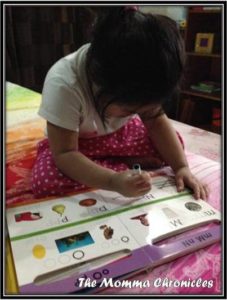 3. Let them scribble.
3. Let them scribble.
If you see my daughters’ playroom, the first thing you will notice is the scribbles on the wall – in different colors. Although I am against it, my husband lets my daughters, especially my youngest, write on the wall and let them explore on their own. Believe it or not, my youngest (who just turned two last June 29) is more inclined in writing and has a better grip than my eldest. She also loves to “write” while reciting the alphabet.
This doesn’t mean you should let your child write on the walls too. The point is allowing your child to scribble early teaches him/her the concept of writing, pen and paper. At the same time, it already teaches the kids and shows them what to do when given writing materials and allows them to explore.
4. Try other “writing” materials.
Pen and paper will always be considered writing materials. However, don’t confine yourself with these two when teaching your little one how to write. Look for other materials that encourage writing such as crayons, paint, sand and even puzzles. Magic slate is also a good place to start. I also downloaded a sort of notepad app where my daughters could just write, draw and be creative using their fingers.
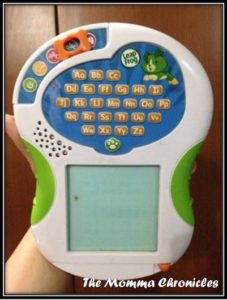
This is the old version. There is a new Scribble & Write available in the market, which includes numbers.
I personally like the letter magnets because I teach my kids to read and write both at the same time through tracing and phonetics. My sister also gave my kids Scribble and Write from Leapfrog. It encourages letter recognition and teaches them how to write (through tracing) letters as well.
5. Indulge them in tracing activities.
I think this is the major factor why my eldest daughter learned how to write on her own. At first, I printed tracing worksheets from Educents, which had Frozen characters in it. We also had “Letter for the Day” writing session, which I got from my favorite online resources (check out where I get my free printable materials here).
Since it’s a bit hassle to print worksheets and I don’t have much scratch paper anymore, I decided to buy writing books so she could just write on it over and over. Before she goes to school, my daughter finally mastered writing the alphabet. 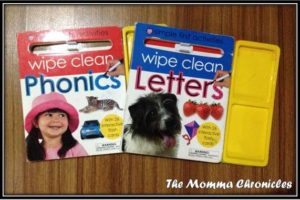 6. Practice, practice, practice.
6. Practice, practice, practice.
This is the most important thing in teaching your kids how to write. Writing should be a constant, daily activity for them to master every line, shape and letter they need to know.
At first, I guide my girls on how to write every letter the proper way. I also teach them the basics such as standing line, sleeping line and curves. It became an everyday habit until such time that they are ready to write on her own. Remember, practice makes perfect, right?
Of course, don’t forget to praise your child for writing on their own, or at least attempting how to write. This gives your child an assurance that s/he is doing a good job and encourages to write more.

Ayi is a stay-at-home mom of two. When her kids are in their best state, she keeps up with chores, work, and ensuring that her sanity is intact. Join her as she navigates through this rollercoaster ride called motherhood.

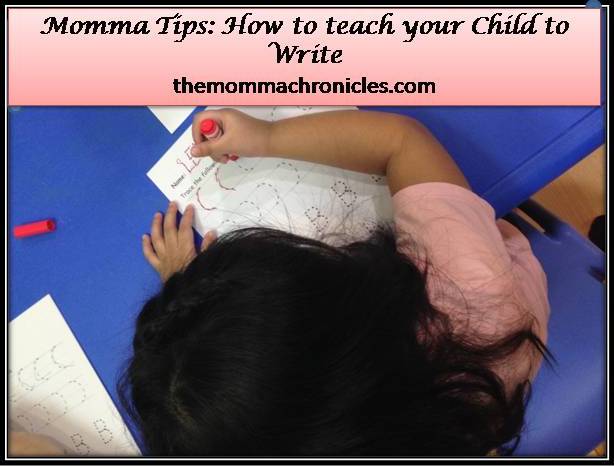


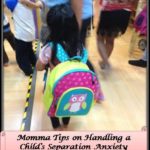










These tips are certainly helpful for moms who are wondering how they can help their kids learn how to write.
i’m also at this stage right now with my youngest. the more you practice them, the more they learn right? another thing that i do is i let her use the “sipit” and put it in the cardboard. it also helps strengthen her grip as well. 🙂
Thank you for sharing these helpful tips. My daughter just turned 3 last April, and I too get frustrated whenever I hear other parents boast about their toddlers who know how to write already. So there are times I tend to force my little kid to learn how to write. But later did I realize that, every kid is unique and we just need to give them time and they’ll eventually have the interest to learn it. ☺️
Oh perfect timing because we’re learning how to trace! We’re using a combination of pen-paper, apps, and toys. But yes, we need a looot of patience!
Hi mommy Maan! It’s good to hear from you again! Kamusta na? 🙂
Practice does indeed make perfect 🙂
Knowing how to write properly is a skill best taught early. I let my son practice writing too everyday. 🙂
oh wow this is quite perfect for jenae! I also went to the link that you had on where to download writing materials for her.. gonna print them out, and it’s perfect cause wala silang pasok until tomorrow 🙂
Very helpful! My daughter also just started Kindergarten this June. I taught her writing her name before the school year. She can write her name but can’t read all the English alphabet yet. No pressure! 🙂
We’ve been doing numbers 1-4. Yey! But I’m not actually teaching my daughter how to write yet so I’ll leave numbers 5 and 6 for that time. But like you, though we try to teach her not to scribble on the walls she sneaks off when we’re not looking and still scribbles. Oh well, kids will be kids. 🙂
Great list Mommy, another way to strengthen those little fingers is by practicing cutting with scissors 🙂 now my 3yo can use them on his own, and now he loves to draw ever since he learned to hold the pen.. And super helpful ng playdough! 🙂
Haven’t tried the scissors yet kasi I’m scared. Hehehe. Thanks for that tip mommy! I’ll get one for my kids 🙂
We have different writing materials at home! It helps so they do not get bored.